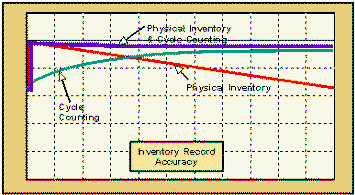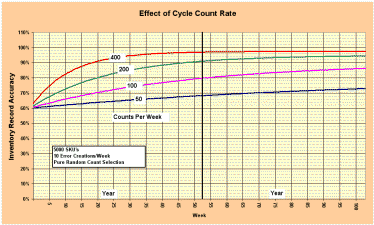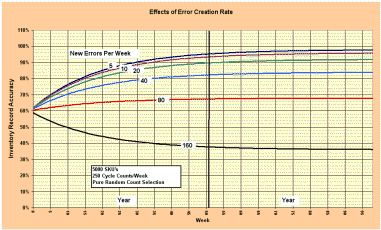Why You Need Prevention As Well As Correction
|

Benjamin Franklin
"An ounce of prevention is worth a pound of
cure."
|
Improving inventory record Accuracy is a worthwhile and necessary goal for most firms. Cycle
counting and physical inventories both correct problems after the fact. Ben Franklin had a
thought about this and Shigeo Shingo would probably have dismissed both approaches as wasteful
and wrong. Nevertheless, most of us are stuck with these approaches, at least for some period of
time.
Cycle counting requires a huge effort and takes months to show results. Physical inventories
give immediate results but require large efforts and cannot sustain accuracy.
A practical and effective approach to Inventory Record accuracy uses both the preventive and
corrective methods of:
-
Physical Inventories
-
Cycle Counting
|
-
Error Reduction
-
Transaction Reduction
|
Error Correction
Figure 13 shows a typical IRA over time when physical inventory is employed by itself (red
line), when cycle counting is used alone (green line) and when the two are used together (purple
line). As discussed previously, the physical inventory gives good and immediate results but
cannot sustain accuracy. Cycle Counting eventually provides excellent and sustainable results
but it takes many months.

Figure 13--Combining Cycle Count & Physical
The combination (purple line) is usually the best approach. The physical inventory
immediately raises IRA. Cycle counting then sustains it at a high level. The precise curve for
an actual situation might differ from figure 13. It depends upon:
|
|
-
Error Creation Rate
-
Number of SKUs
|
Figure 14 shows the effect of cycle count rate. In this example 200 counts/week results in an
IRA of 94%. A rate of 100 counts/week peaks at about 84% and in both cases it requires almost
two years to reach the maximum accuracy. A rate of 400 counts/week gets a 98% accuracy after one
year.
|

Figure 14-- Cycle Count Rate (Click To Enlarge)
Error Prevention
The rate at which new errors are crated and introduced to the inventory system also affects
both the maximum achievable accuracy and the time required to approach this level of accuracy.
Figure 15 shows a typical system and how error creation affects it.

Figure 15-- Error Creation Rate (Click To
Enlarge)
With an error rate of 40 errors/week, the maximum obtainable IRA is about 84%. with an error
creation rate of 10 errors/week the IRA is 96% and accuracy increases much faster in the early
weeks.
Designing & Implementing the IRA System
The details of these tasks are part of our training program on
Cycle Counting & Inventory Record Accuracy.

|





